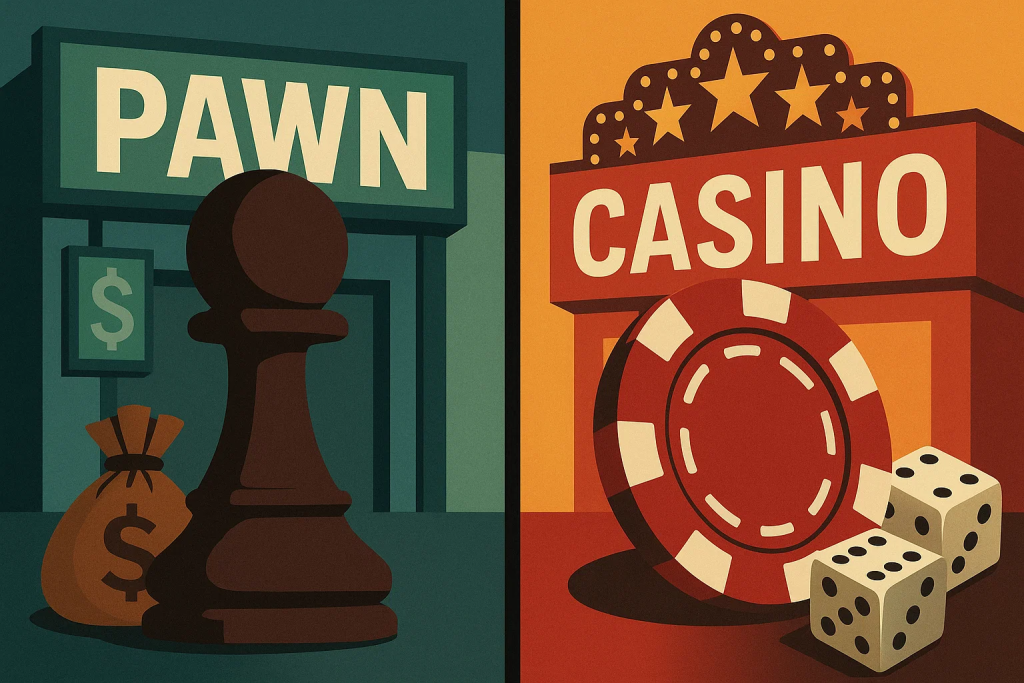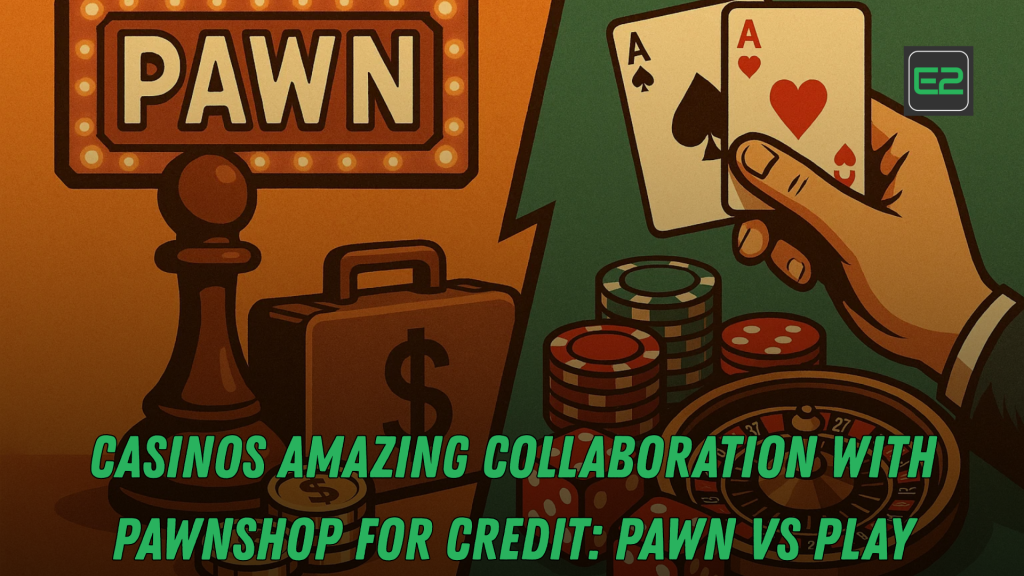Table of Contents
Pawnshop for Credit: The collision between physical collateral and cashless wallets is reshaping how players fund entertainment on the casino floor. In markets where real-time identity checks and alternative lending have matured, a new bridge has emerged: casino pawnshop credit. At its best, this model offers transparent, short-term liquidity with sensible limits and audit trails. At its worst, it can encourage impulsive borrowing that harms players and reputations. This long-form guide takes a practitioner’s view of the opportunity and the risks, showing operators, lenders, regulators, and players how to build a safer, smarter future for casino pawnshop credit without hype or harm.

Definition and Scope
“Pawn vs Play” describes a structured workflow in which a guest temporarily pledges a tangible asset—watches, jewelry, electronics, or authenticated collectibles—in exchange for short-term funds that can be moved into a casino wallet or the cage. Crucially, two domains remain separate: a licensed lender handles underwriting, custody, and disclosure, while the venue manages identity, gaming limits, and duty-of-care. When these boundaries are real, casino pawnshop credit becomes a bridge between non-bank wealth and entertainment spend that is auditable, capped, and reversible.
Why It’s Rising Now
Three macro forces explain the surge. First, consumers expect instant access to funds in every domain, so delays feel like defects. Second, a meaningful share of personal wealth now lives in non-bank assets that are easy to authenticate but slow to liquidate; unlocking them temporarily is attractive. Third, regulators prefer transparent rails over untracked, informal credit. When run responsibly, casino pawnshop credit satisfies all three: it is fast, it uses assets people already own, and it creates a clean, auditable record.
How the Workflow Operates (Step by Step)
- Intake and Identity – The guest presents the asset and government ID. KYC, sanctions, and PEP checks run in seconds.
- Authentication and Appraisal – Staff record serials and photographs; reputable catalogues and recent auction data inform value ranges.
- Loan-to-Value Offer – The system proposes a conservative LTV to absorb volatility. With casino pawnshop credit, typical LTVs range from 25–60% for stable categories.
- Disclosures and Consent – Plain-language terms show interest, fees, storage rules, redemption windows, and default consequences.
- Funding and Settlement – Net proceeds post to a closed-loop wallet or the cage; accounting segregates lending from gaming balances.
- Cooling-Off and Affordability – A short delay and affordability checks reduce hot-state decisions; well-built casino pawnshop credit places friction where it protects people.
- Repayment and Redemption – The borrower reclaims the asset by repaying principal plus costs; extensions follow strict caps to prevent harmful rolling.
- Audit and Reporting – Every step lands in immutable logs to satisfy internal review and external oversight.
The Economics for Each Party
- Player: Unlocks liquidity without selling; the trade-off is cost and the risk of liquidation if deadlines are missed.
- Lender: Earns interest and fees while holding collateral; underwriting quality, custody rigor, and fair pricing determine outcomes.
- Venue: Gains incremental handle and wallet utility without carrying loan risk; the obligation is to keep casino pawnshop credit aligned with responsible-gaming standards.
Value is created when LTVs are conservative, pricing is explicit, tenors are realistic, and custody is boringly excellent. Value is destroyed when any of those levers are abused.
Compliance, Licensing, and Risk Ownership
Because lending and gaming are both highly regulated, leaders map requirements before a single dollar moves. They ensure parity between the pawn partner’s KYC and the casino’s identity program; they create shared protocols for suspicious patterns; and they set bright-line rules for politically exposed persons, disputed ownership, and cross-border tourists. The north star is traceability: in a mature casino pawnshop credit program every decision can be reconstructed and justified.
Responsible-by-Design: Ethics as Product Features
A harmful system is often just a well-intentioned system with the friction removed. Product teams should slow the journey at the right moments and illuminate the true cost. That means timers that delay wallet activation, budget labels distinguishing borrowed funds, alert tiles showing total repayment before a single bet, and reminders that make redemption easy. When casino pawnshop credit ships with these defaults, it signals that the operator takes human outcomes seriously.
Player Decision Framework
Before pledging an item, ask: Do I understand total repayment in my home currency? Can I lose both the borrowed funds and access to the asset and still be okay? Am I borrowing to chase losses, or to fund a planned night out? Is there a lower-stakes option that preserves fun without borrowing? What is my exit if I change my mind? Clear answers indicate healthy use of casino pawnshop credit; fuzzy answers are a sign to pause.
Operating Model: Who Does What
The most resilient partnerships assign ownership unambiguously. The pawn partner owns underwriting, custody, insurance, and collections. The casino owns identity, play limits, cooling-off enforcement, and all responsible-play interventions. Both parties own the customer’s trust. Training focuses on product literacy and empathy. Staff learn to explain LTV, fees, storage, and redemption in everyday language, and to recognize behavioral signals that suggest a pause. The tone should be calm, precise, and patient. When these norms hold, casino pawnshop credit feels like a service, not a sales pitch.
Technology Stack: Secure, Seamless, Auditable
Three integrations matter most under the hood. First, real-time APIs keep pawn tickets, wallet balances, and cage transactions in sync. Second, custody controls record serial numbers, images, chain-of-custody events, and storage locations with time stamps. Third, risk engines blend identity confidence, device reputation, affordability signals, and play history to trigger guardrails. Analytics then track conversions, redemptions, complaints, and self-exclusions. Mature teams iterate policies with data, not anecdotes, which is how casino pawnshop credit improves quietly every quarter.
Pricing and Terms: The Fair Middle
Short-term collateralized lending is costlier than a prime bank loan but should never be predatory. Transparent menus beat fine print: post the APR, show total cost at common tenors, explain storage and authentication fees, and cap extensions firmly. Incentives should reward on-time redemption rather than encourage rollovers. Because the reputation of casino pawnshop credit depends on predictability, surprises are the enemy.
Marketing Without Harm
If you offer the service, market it with humility and accuracy. Use educational copy, repayment calculators, and realistic examples. Avoid hype or the illusion that liquidity equals luck. Invite customers to set personal limits before they borrow, and emphasize that casino pawnshop credit is optional, capped, and integrated with self-exclusion. A restrained message outperforms a flashy one because trust compounds while complaints fade.
Healthy vs. Harmful Case Patterns
Healthy pattern: A traveler pawns a watch at 35% LTV, receives wallet funds after a two-minute delay, plays within a preset entertainment budget, and redeems the item the next morning.
Harmful pattern: A guest arrives during a losing streak, accepts an aggressive LTV on a volatile collectible, rolls the ticket twice, and misses the redemption window. The asset is liquidated, the guest is distressed, and the venue’s brand takes the hit. The difference is not luck; it is the discipline of casino pawnshop credit design and the tone of frontline conversations.
90-Day Implementation Roadmap
- Days 1–30: Policy and Process. Map jurisdictional requirements, define ownership, draft contracts, and write playbooks for edge cases.
- Days 31–60: Build and Integrate. Connect APIs, stand up custody rooms, pilot affordability checks, and run staff training with real scenarios.
- Days 61–90: Pilot and Iterate. Launch in one property with conservative caps, run weekly audits, publish dashboards, and tune LTV and tenor rules. A controlled rollout demonstrates that casino pawnshop credit can be commercially meaningful and ethically sound.
KPIs That Actually Matter
Ignore vanity metrics and focus on health. Track redemption rates by asset class; average LTV dispersion; complaint volume and resolution time; affordability-check pass rates; self-exclusion matches blocked before disbursement; and NPS segmented by first-time versus repeat users. These are the dials leaders watch when they want casino pawnshop credit to endure beyond a press release.

Legal and Geographic Nuance
Lending and gaming are jurisdiction-specific. Some markets require separate entrances and signage; others mandate escrow-like custody or restrict where funds can be used. Cross-border tourists raise tax and customs questions; domestic guests raise community-impact concerns. The common denominator is documentation: if every decision inside casino pawnshop credit is traceable, provable, and necessary, your odds of passing both regulatory and public-opinion tests increase.
Future Trends: Tokenization, Remote Intake, Smarter Valuation
Expect three shifts. First, tokenized representations of luxury goods and collectibles will streamline custody and speed redemption. Second, remote intake—courier lockers, partner boutiques, and verified video appraisals—will extend casino pawnshop credit beyond the resort footprint while preserving auditability. Third, valuation engines will learn from auction data and service histories, producing tighter LTV bands and fairer pricing. The safest growth for casino pawnshop credit comes from better data, better custody, and better consent.
A Player’s Practical Checklist
- Bring documentation—receipts, certificates, or grading reports—to support authentication.
- Photograph your item before and during intake; confirm serial numbers match the ticket.
- Read the total-repayment line first, not the APR—short terms can make small APRs expensive.
- Decide on a hard budget and time limit before you borrow.
- If emotions run hot, use the pause: ethical casino pawnshop credit solutions make waiting easy and changing your mind even easier.
An Operator’s Practical Checklist
- Train for empathy and precision, not pressure.
- Publish repayment calculators and sample scenarios on property and online.
- Default to conservative LTVs for volatile categories; review outliers daily.
- Wire self-exclusion directly into disbursement logic.
- Treat custody like a bank vault. The trust in casino pawnshop credit is earned through small, boring details that most guests will never see but always feel.
Myths and Facts
- Myth: Only desperate people use collateral loans in casinos. Fact: Many guests use short terms for convenience, but healthy use requires caps, clarity, and cool-down periods.
- Myth: The casino profits more when customers roll loans. Fact: Rollovers increase complaints and scrutiny, often erasing any short-run revenue.
- Myth: Assets frequently go missing. Fact: Proper chain-of-custody, cameras, and logged access make loss nearly impossible in a mature casino pawnshop credit environment.
- Myth: Regulators will eventually ban the practice. Fact: Transparent, auditable programs that prioritize consumer protection are more likely to be approved and sustained.
SEO Corner: Building Content That Educates and Converts
Searchers are not only asking who offers the service; they are asking how to use it safely. Your content strategy should mirror this article’s structure: clear definitions, eligibility, LTV examples, repayment calculators, redemption timelines, custody guarantees, and responsible-play links. Write comparison guides that explain casino pawnshop credit versus bank credit, versus selling the item outright, and versus simply lowering stakes. Offer downloadable checklists and multilingual FAQs. Most importantly, keep pages updated with policy changes, and link to help resources so visitors can self-assess whether casino pawnshop credit makes sense for their situation.
Conclusion
When liquidity meets entertainment, incentives can blur. The industry’s responsibility is to build systems that slow people at the right moments, reveal costs clearly, and celebrate redemption as much as play. Do that, and casino pawnshop credit becomes a quiet, respected service that guests describe as fair, predictable, and human. Fail to do that, and the same mechanism becomes a headline and a hearing. The difference is design, governance, and daily habits.
“Pawn vs Play” refers to a structured model where guests temporarily pledge valuables—watches, jewelry, electronics, authenticated collectibles—to unlock short-term funds that post to a casino wallet or cage. A licensed lender manages underwriting, valuation, custody, pricing, and disclosures, while the casino controls identity checks, responsible-gaming safeguards, spend limits, and audits. When these roles stay separate and transparent, casino pawnshop credit becomes an auditable, capped liquidity bridge rather than risky, informal lending.
The workflow is straightforward: KYC/PEP/sanctions screening; authentication and appraisal using serials, photos, and market references; conservative loan-to-value (often 25–60% depending on asset class); plain-language terms covering APR, fees, storage, redemption windows, and default consequences; near-instant funding to a closed-loop wallet; a brief cooling-off delay and affordability checks; repayment and redemption or carefully governed extensions; immutable logging for AML and consumer-protection reviews.
Economically, players gain liquidity without selling; lenders earn interest with collateral in custody; casinos increase handle and wallet utility without holding loan risk. Value is created by accurate LTVs, clear pricing, tight custody, realistic tenors, and firm rollover caps. Risks include over-borrowing, asset mispricing, fraud, data leakage, and reputational harm—mitigated by guardrails like delays, spend caps, dual appraisals, chain-of-custody controls, and dispute channels.
A responsible program builds friction where it protects people: budget labels for borrowed funds, repayment calculators, high-visibility payoff totals, self-exclusion integration, and empathetic staff training. The tech stack connects pawn, wallet, and cage via APIs; hashes custody events; scores risk from identity, device, affordability, and play history; and tracks KPIs such as redemption rates, LTV dispersion, complaint resolution, self-exclusion blocks, and NPS.
Marketing should educate, not hype. Looking ahead, tokenized luxury items, remote intake, and smarter valuation engines will likely expand access while improving fairness. Bottom line: with transparency and guardrails, casino pawnshop credit can be a fair, auditable service; without them, it amplifies risk.

Call to Action
Operators: Audit funding touchpoints, map protective friction, and pilot a capped, transparent version of casino pawnshop credit in one venue before scaling.
Players: If you are considering a loan against an item, run the “Can I lose both and be okay?” test first. If the answer is no, wait.
Advocates and Regulators: Publish plain-language standards so the best practices of casino pawnshop credit become the baseline everywhere.
Frequently Asked Questions
1) Is this legal everywhere?
No. Pawn, lending, and gaming rules vary widely. Verify that both the lender and the venue carry the right licenses and that casino pawnshop credit contracts meet local disclosure and custody standards.
2) How much can I borrow?
It depends on the asset and the market. Stable luxury goods often support 25–60% LTV; volatile or unique items may qualify for less. Conservative LTVs are a feature, not a bug, when you want casino pawnshop credit to be sustainable.
3) What happens if I cannot repay on time?
Quality programs provide clear grace periods and transparent liquidation rules. If repayment does not occur, the asset may be sold to cover costs according to the signed terms. Good casino pawnshop credit policies make consequences obvious up front.
4) Does using this service change my gaming limits?
It should. Responsible operations link affordability and self-exclusion to disbursement, so casino pawnshop credit can never bypass the safeguards that protect customers.
5) How do I know whether the fees are fair?
Look for posted APR bands, total-repayment tables, storage fees, and examples at different tenors. The best providers include calculators, sample tickets, and staff who can explain casino pawnshop credit in straightforward language.
